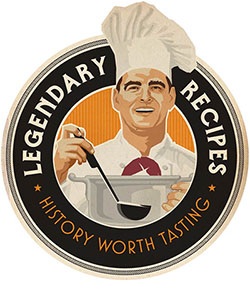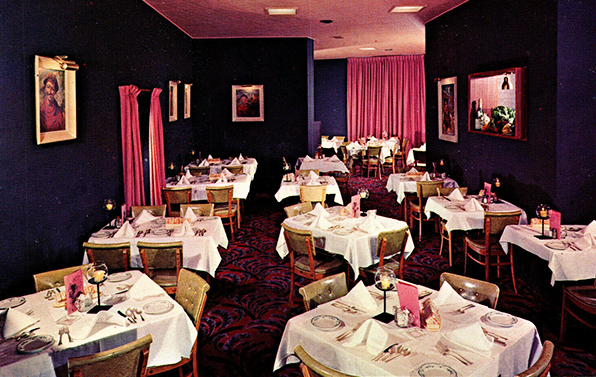In 1951, when a columnist for the Oakland Tribune christened Mitchell Hoffman “the popular prince of maitre dees,” he might well have added that Hoffman had been in training for that role his entire adult life.
Hoffman, who was born in 1920 in Winnipeg, Canada, became a full-fledged Californian four years later when his family moved to San Francisco. In high school he was a standout in swimming, water polo, and basketball, so much so that at the end of his senior year he won a spot in a field of 14 swimmers chosen to race from the Marin County shoreline to the rocks of Fort Point on May 7, 1937, as part of the Golden Gate Bridge’s massive opening-day celebration. That fall Hoffman enrolled in the City College of San Francisco, and on graduating four years later with a degree in hotel and restaurant management he took a job at the St. Francis Hotel in San Francisco. In 1942, following the Japanese attack on the U.S. naval base at Pearl Harbor, he was drafted into the U.S. Army and served at the Presidio of Monterey.
Following his discharge from the army in 1946, Hoffman landed a job as the manager of the Hotel Senator in Sacramento. But then Dewey Bargiacchi, one of his army buddies at the Presidio, made him an offer he felt he couldn’t turn down. “Dewey asked me to come to Oakland,” Hoffman would later recall, ”and found a job for me in his family restaurant, the old Villa de la Paix.” In 1952 he took over management of Villa Lorenzo, a new restaurant in the planned community of San Lorenzo, but soon returned to Oakland to become the manager of New Milani’s on Grand Avenue. The following year he became the general manager of the newly opened Sea Wolf restaurant on Jack London Square.
In 1953 Sophie Gwerder, the proprietor of Sophie’s, a popular restaurant at 529 17th Street, learned that the Cotati Inn, in her hometown of Cotati, about 50 miles north of Oakland on U.S. Route 101, was for sale. She immediately bought it and renamed it Sophie’s Cotati Inn, and while she told reporters that she and her husband, Mike, intended to operate both restaurants, her professed determination didn’t last very long. Hoffman soon bought Sophie’s and completely remodeled and redecorated its interior. He opened Mitch’s there on January 12, 1954.
Hoffman, who favored custom-tailored suits and traded his horn-rimmed glasses for an identical pair without lenses whenever he was asked to pose for a photo, may have been the best-dressed restaurateur in Oakland. He greeted guests with gusto as they entered the restaurant, which offered four separate dining rooms, a large banquet room, and a cocktail lounge (with a piano bar) separated from the dining area by glass showcases filled with bottles of wine and glassware. Hoffman decorated his restaurant with original oil paintings (obtained through an uncle who owned a high-end art gallery in San Francisco) and an impressive collection of wood carvings by Emil Janel, a Swedish-born artist who lived and worked in Rio Nido, a resort community on the Russian River in Sonoma County.
In 1955 a fire closed Mitch’s for 79 days, but when Hoffman reopened the restaurant it seemed busier than ever. Part of the reason was Bob Viani, a well-known chef in the East Bay, who headed up the kitchen, but the bigger factor was Hoffman himself, an affable and gregarious host who seemed to know everyone in the by name. “Credit Mitch Hoffman, Oakland’s 17th Street restaurant tycoon, with doing the most outstanding job of the year,” Bob Tuttle, a columnist for the Contra Costa Times, wrote. “While many clubs are having trouble with the red ink, likeable Mitch just keeps smoking those Churchill cigars and building up his bank account.” For Hoffman, 1957 was also a banner year: In July he married Marian Vezzani.
In 1959 Hoffman was advertising Mitch’s as “The ‘Toots Shor’s’ of Oakland,” and in 1964 as “Oakland’s Favorite Downtown Dining Address.” There was a bit of hyperbole in both claims, but his restaurant was as well-known as any in downtown Oakland and a worthy destination for chops, charcoal-broiled steaks, roasts, fish, and specialty dishes like Beef Stroganoff and Lobster Buccaneer.
In 1965 Hoffman decided to sell Mitch’s so that he could take a position with Cal Neva Lodge in Crystal Bay, Nevada. The resort and casino, built on the shores of Lake Tahoe in 1926 and so named because it straddled the border between California and Nevada, had been owned since 1960 by Frank Sinatra and several other investors. (By one account it was Sinatra himself who lured Hoffman there.) But Hoffman clearly missed Oakland, going so far as to ask one newspaper columnist there to print his telephone number and encourage his friends to get in touch with him.
The new owner of Mitch’s, Homer C. Rose, brought on Sam “Hats” Gomora as chef and Russ Amato as maître d’. (Gomora had acquired his unusual nickname because he liked to wear brightly colored plaid, polka-dot, and paisley chef’s toques and matching kerchiefs rather than the traditional white versions and was said to keep some 48 different cap-and-kerchief sets in constant rotation.) But Mitch’s was never the same without Mitch, and year by year the restaurant declined with the rest of downtown Oakland. It closed and reopened at least once before it was quietly shuttered in 1969. A new restaurant, Mario’s, replaced it but didn’t last long there, as by 1971 Tommy’s Restaurant had taken over the space on 17th Street.
As for Hoffman, he’d returned to Oakland in 1967 and, with fellow restaurateur Jim Castello as a partner, opened the Sir Loin Restaurant at 3423 Grand Avenue. To many it seemed just like Mitch’s in a new location, from the oil paintings on the walls to the chops, steaks, and prime rib on the menu. In time Hoffman came to own the Sir Loin on his own and operated it until 1985, when he announced that he was retiring. But three years later he came out of retirement to become the night manager of Francesco’s Restaurant at 8520 Pardee Drive, near Oakland International Airport.
Hoffman died in Oakland in 2005 at age 85.
Famous Patrons of Mitch’s
- Johnny Gonsalves
- C.L. “Brick” Laws
- Art Michalik
- Leo Nomellini
- Lefty O'Doul
- Buck Shaw

Lobster Buccaneer
Ingredients
- 4 tablespoons unsalted butter
- 1 1/2 pounds prawns, peeled, deveined, and diced
- 1 pound cooked crabmeat, picked over for shells and flaked
- 1 pound cooked lobster, diced
- 1/2 cup all-purpose flour
- 4 cups scalded milk
- 6 tablespoons brandy
- 1/4 cup dry sherry
- Salt, to taste
- Pepper, to taste
- 1 1/2 cups grated American cheese
Instructions
Heat oven to 350 degrees. Place six half lobster shells or individual baking dishes on a baking sheet and set aside.
In a large skillet, melt the butter over medium heat. Add the diced prawns and sauté until they are a brilliant pink in color.
Using a slotted spoon, transfer the cooked prawns to a bowl. Add the crabmeat and lobster and lightly toss together the seafood.
Using a whisk, slowly blend the flour into the butter remaining in the skillet until the mixture forms a roux. Cook over medium-low heat, whisking frequently, about 2 minutes. Gradually whisk the scalded milk into the roux, stirring constantly, and cook over medium heat until the sauce begins to simmer and thicken, 2 to 3 minutes.
Remove the sauce from the heat and whisk in the brandy and sherry until the sauce is smooth. Season the sauce to taste with salt and pepper.
Gently fold the seafood into the sauce. Taste and adjust the seasoning, if necessary.
Carefully spoon the mixture in equal portions into the six empty lobster shells or baking dishes and sprinkle each one with grated cheese.
Place the baking sheet in the 350-degree oven and bake until the mixture is hot and the cheese is lightly browned, 10 to 12 minutes.
In Our Vault: More Recipes from Mitch’s
- Beef Stroganoff over Egg Noodles










No Comments